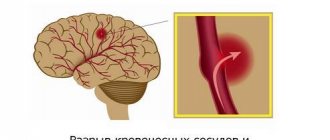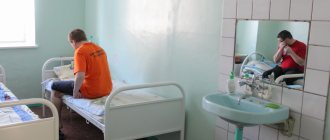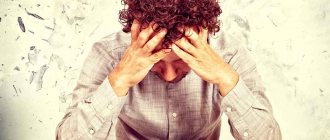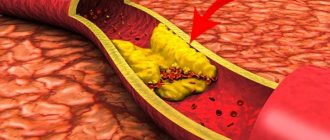| Calling a psychiatrist to your home from RUB 3,500. | 24-hour hospital from 6000 rub. | Outpatient treatment from 4500 rub. | Hospitalization (transportation) to a hospital from 2000 rubles. | Psychiatric examination from 1500 rub. |
Fears or phobias are caused by strong feelings and excessive anxiety in specific situations or in anticipation of the manifestation of an unusual object.
What are fears and phobias - in the field of psychiatry, a phobia is usually called a pathology in which a strong fear of various factors or objects develops. Phobias are expressed by seriously impassable fear, which is irreversibly aggravated in certain situations and cannot be fully explained logically. As a result of the development of a phobia, a person begins to fear and therefore avoid certain objects, activities or situations.
Treatment of fears and phobias in a hospital. Prices
| Economy | Standard | VIP chamber |
| 6000 rub./day | 7000 rub./day | 8000 rub./day |
The hospital price already includes:
- Full diagnostics in the laboratory
- Individual therapy plan
- Medicines required for treatment
- Choosing a room to stay
- Balanced 3 meals a day from the chef
- Group and individual psychological therapy
- Regular monitoring of patient progress
- Therapeutic massage, exercise therapy
- Physiotherapy and yoga therapy
- Complete and constant cleaning of rooms
- Buffet open 24 hours a day
- Gym, table tennis room
- Free WI-FI, games, movie shows
- Convenient parking and walking area
Stages of treatment for phobia in hospital
To treat a phobic disorder in Moscow, you need to go through the most important stages:
- work through phobias;
- take antidepressants;
- use tranquilizers;
- undergo psychotherapy sessions.
1) Primary diagnosis
Before treating asthenic syndrome in Moscow, the patient undergoes a high-quality diagnosis, tests are collected and a full examination is carried out. Specialists also conduct psychological diagnostics, take tests, conduct an ultrasound examination, study a cardiogram, and the patient is examined by a neurologist.
2) Treatment plan.
Based on the collected data, tests and conversations with doctors, an individual treatment plan will be prescribed for the person. If the situation is controversial and the case is severe, professors and specialists will be involved in the problem to prescribe an individual plan for further treatment. They will select treatment options with medications and psychological therapy.
If a patient has an acute condition, he poses a danger to himself and his loved ones - a special team will come home to pick him up. They will help transport him to the hospital and treat this condition in the hospital.
3) Therapy. After establishing an individual therapy plan for indolent manifestations of the disease, the patient is treated with medications + psychological therapy (both alone with a specialist and in a group).
How are mental disorders defined?
According to the World Health Organization, the main signs of a mental disorder are changes in thinking, mood or behavioral reactions that go beyond the generally accepted norms of law and morality. A person is considered ill if he or she exhibits abnormal ability to learn, perform work, and has an increased risk of death, suffering, or impairment.
In the emotional sphere, a patient with a deviation experiences either an excessive reaction to events, a feeling of deep grief or euphoria. Some mental pathologies are accompanied by absolute emotional dullness without any adequate manifestations of feelings.
There is a logical connection in the patient’s thinking, and there are overly negative or extremely positive judgments about oneself, people or events. There is often a lack of ability to critically evaluate a situation or one’s actions. The behavior of such a person is striking in the presence of meaningless physical activity, obsessive actions, and sexual perversions.
Treatment of mental disorders requires preliminary diagnosis. First, it is necessary to exclude somatic diseases. And only in their absence will we talk directly about mental illness. They are determined by clinical symptoms and the method of conducting various tests.
Benefits of treating phobias in a hospital
- 24/7 monitoring. Our doctors monitor the health of patients around the clock.
- Isolation from familiar surroundings. The patient cannot leave the center during the course of therapy. Only close relatives can visit him by appointment.
- Proper nutrition. For patients, we offer a varied menu and meals 3 times a day. All dishes are prepared by good chefs.
- Living with relatives. In our clinic you can live with relatives in the same room.
Family therapy in the treatment of phobias
Treatment of fears with hypnosis, medications and the help of a psychiatrist in the treatment of phobias are necessary help for patients. But it is also important to pay attention to family psychotherapy with this illness. The help of a psychiatrist in treating fears for all family members is very important. Because it is the relatives who live with a sick person who can help him cope with phobias and fears. The doctor will also be able to quickly understand the causes and treatment of the patient’s phobias.
Who treats phobias - if you want to make an appointment with a psychiatrist in Moscow, pay attention to the qualifications of the specialists who will deal with the patients’ problems. In our clinic, neurologists, therapists and psychiatrists work with people with phobias and provide anonymous treatment.
Panic attacks. Stop being afraid of them. Psychologist's advice
Many people complain about panic attacks, but not everyone understands the essence of this phenomenon and therefore they are even more afraid. Often people who have experienced a panic attack are so frightened by this that they subsequently live in constant fear of a repetition of this “terrible” state.
Let's clarify what this disorder consists of and why it causes such a public outcry.
One should not think that panic attacks are something new, hitherto unknown to science, it’s just that in our age of loud slogans they have received a new name, brighter and more noticeable than “paroxysmal anxiety disorder”, “VSD” or “sympathoadrenal autonomic crisis”. Of course, doctors knew about this disorder before the beginning of the twenty-first century, it’s just that people in non-medical professions knew less about it, and with the advent of the Internet, panic attacks began to seem like the trend of the century.
The disease manifests itself in the form of sudden attacks of anxiety, accompanied by an increase in heart rate, sudden changes in blood pressure, sweating, discomfort in the chest and abdomen, often a feeling of nausea, a feeling of shortness of breath, palpitations, dizziness and an altered perception of what is happening, and often reaches the fear of losing sanity or sudden death. No wonder: the person just felt quite comfortable, and suddenly there is such a “bouquet” of bright unpleasant symptoms. The emergence of fear logically follows from the above, but, unfortunately, it further aggravates the condition.
One of the means of combating diseases is prevention, so in this case, developing a certain attitude towards such attacks in advance means coping with them to a large extent.
Anxiety is fear without an object, fear of uncertainty, the unknown. In the modern metropolis there are too many factors influencing a person, so it is not surprising that anxiety disorders are so common. And if an anxious person has an attack with increased heart rate, a surge in blood pressure, and dizziness, whoever wants to think about a heart attack or stroke. Fortunately, anxiety attacks go away on their own in a short time, leaving no consequences.
Fear and anxiety are necessary feelings that prepare us to face danger. We must be ready to run away or fight, and therefore fear and anxiety are associated with rapid changes in the body.
Firstly, to react quickly, you need speed - and the amount of adrenaline in the blood rapidly increases. Secondly, it is important to prepare more strength - and at the same time the heartbeat increases, the breathing rate increases (even a feeling of lack of air appears) in order to deliver more oxygen and nutrients to the muscles, and thirdly, for the same purpose, the vessels serving the muscles dilate.
At the same time, all other processes in the body slow down, the vessels in the digestive system narrow, and the stomach shrinks. Associated with this are two symptoms that are similar in their purpose – “bear sickness”, that is, the urge to empty the intestines in a stressful situation, and nausea – as the intention not to waste effort on unnecessary digestion at this moment.
Sweating is explained by intense metabolic processes in the muscles and an increase in temperature, and dizziness is explained by the same increased blood circulation: the brain receives too much oxygen and “gets drunk”, which, against the background of anxiety, can easily be confused with a violation of the perception of reality.
To distinguish a panic attack from a stroke, you need to remember that a stroke is accompanied by numbness or muscle weakness, and loss of the ability to speak. During a panic attack, body and facial movements may be symmetrical. During a heart attack, the pain behind the sternum is prolonged, there may be pain in the left arm, and fear appears due to pain. With panic, a lack of air is felt to a greater extent; fear is associated not with pain, but with pulse rate, increased pressure, dizziness and, in fact, is not a consequence, but a cause.
If you experience sudden attacks of anxiety, it is important to know that their physical, bodily manifestations are not dangerous, because they are not caused by poison entering the body, or a sudden failure in the functioning of important body systems - no, this is a chain of reactions that the brain launched in order to prepare you for an emergency response to an uncertain life situation. In the entire history of medicine (since the time of Hippocrates), not a single case of a panic attack has been recorded that would have led to any serious complication or death. On the contrary, doctors observe such a pattern that people with panic attacks are distinguished by good physical health, their life expectancy is usually longer than the average.
As clinical experience shows, those who cease to be afraid of the recurrence of panic attacks get rid of them forever!
Of course, it would also be wrong to treat a symptom such as a panic attack with disdain, so it is important to get checked by a psychiatrist or psychotherapist, and sessions with a psychologist will help you correct the reason why your brain considers current life circumstances to be dangerously uncertain.
What happens if phobias are not treated?
If a person’s phobias are not identified in time, he or she will be at risk of developing the following consequences:
- serious depression;
- alcoholism and drug addiction;
- personality disorders;
- panic attacks.
- suicide attempts.
Below against the background of a mourning black ribbon. It is advisable to collect statistics on deaths according to WHO or other authoritative sources
The worst risk with phobias is that a person can commit suicide in this state.
FAQ
What is the difference between fear and phobia?
Fear is a normal protective reaction of the body to a dangerous situation. After the fear factor is eliminated, the condition returns to normal, and the symptoms no longer return. If an uncontrollable feeling of fear occurs regularly without any known reason, this means that the person has a phobia.
Is phobia an incurable pathology?
The disease responds well to therapeutic measures; the main thing is to approach this issue correctly and competently. Treatment methods are selected depending on the severity of the pathology, symptoms and the cause that caused it. The effectiveness of therapy in this case directly depends on the patient’s desire to get rid of the phobia.
Is it possible to cure the disease on your own?
It is better to consult a doctor, as improper treatment will only make the disease worse. An experienced psychotherapist works using modern methods and knows which one is best to apply in a given situation.
Is it possible to die from a phobia?
Despite the fact that there is an expression “I almost died of fear,” cases of death are practically excluded. There are situations when, in a state of panic, a person loses self-control and can harm himself. This phenomenon is very dangerous and leads to serious consequences, including death. This is why you should not self-medicate. It is better to contact a psychotherapist as soon as possible.
Is it possible to get rid of a phobia that has been haunting you for several years?
It doesn’t matter how many years a person suffers from a phobia - the disease can be treated at any time. For this, there are special techniques that relieve the patient from panic attacks once and for all.








